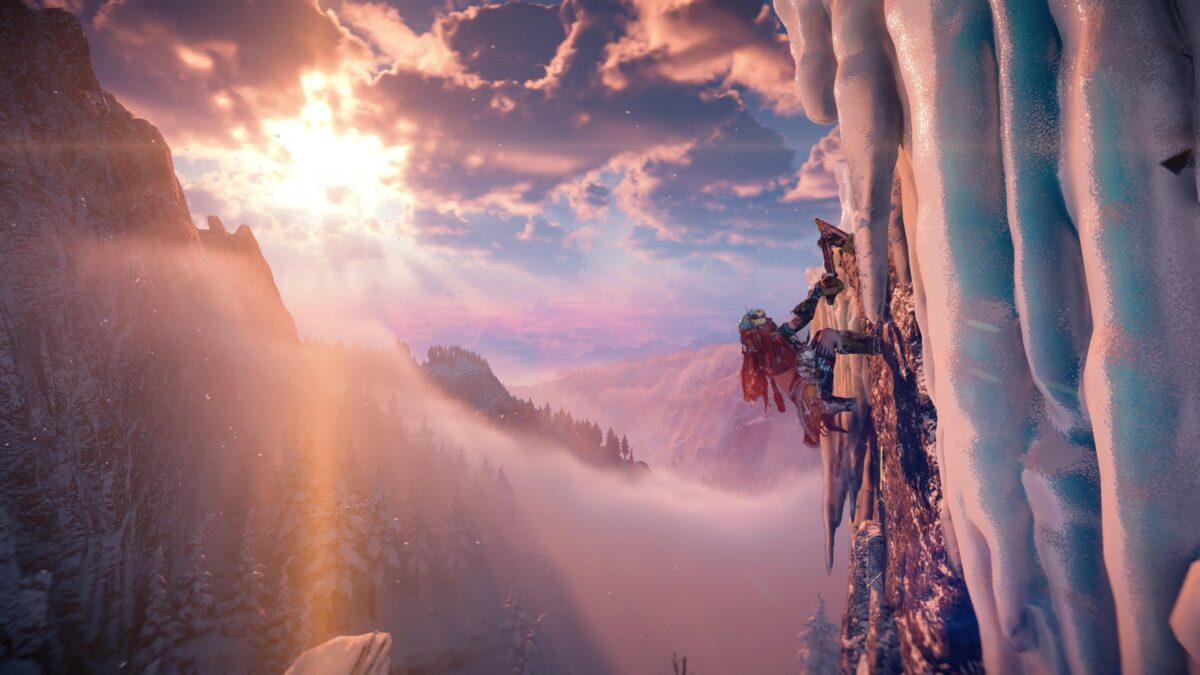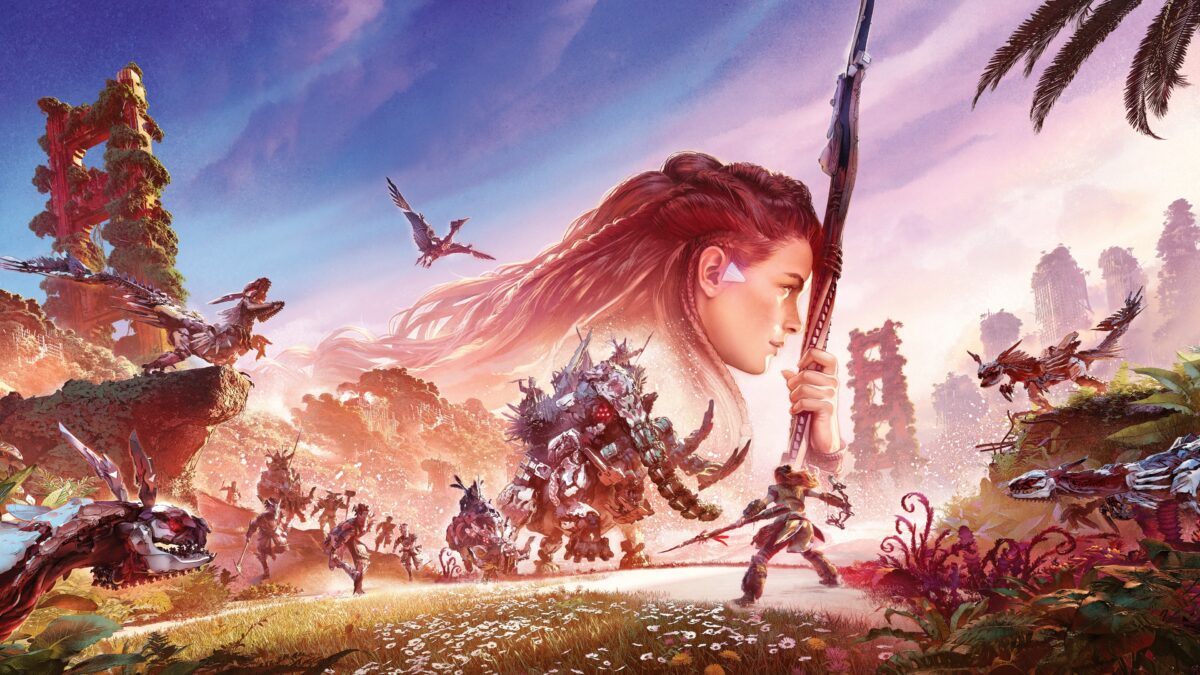When I think back to Horizon Zero Dawn, there isn’t much I can recall about the tribes of its post-apocalypse world. Sure, I remember they were superstitious and scared of technology, but most people would be if giant, mechanized dinosaurs kept crushing their relatives. We’d at least think twice before using our toasters, eh?
Horizon Forbidden West is much more memorable, much richer. It sells the fantasy of stepping into an alternate vision of Earth where belief systems have been shaped by their surroundings – an Earth where terraforming machines have gone rogue. I’ll always remember the first time I rode into Plainsong, a village built into derelict satellite dishes with bamboo paths winding up the array, wicker weave melding with the dish basin.
[mm-video type=video id=01fvtfvfnmvbgkt4vv89 playlist_id=none player_id=none image=https://images2.minutemediacdn.com/image/upload/video/thumbnail/mmplus/01fvtfvfnmvbgkt4vv89/01fvtfvfnmvbgkt4vv89-5d6603922ef88e15fbe5b753a93fcb66.jpg]
The fields and rice paddies surrounding the village are tainted by the blight, a poisonous growth that reddens the soil and crops while kicking harmful spores into the air, choking Plainsong’s citizens, the Utaru. But the people of Plainsong soldier on, believing that their ‘Land Gods’ – docile machines that tend to the Earth – will make everything right again. Each Utaru carries a seed encased within a piece of jewelry attached to their chest, allowing them to give back to the land they revere when they die. Everyone who lives here is tied to the place because the trees and bushes are their lost friends and relatives. Rather than becoming perpetual consumers, they’re in harmony with the land. The Utaru would stick a spear in you before you could even whisper the words “non-fungible”.
Ecological kindness is at the heart of the game, too. The tree-hugging message doesn’t always synergize with a game where you murder thousands of animals so you can craft a quiver that carries more arrows, but it’s handled with tact in the story itself, which asks disparate people to come together against an existential threat. It helps that the quality of writing here is much improved over the first game, even tackling the mechanical war elephant in the room – colonialism – by having you actively fight against the tribes’ oppressors. You’re not here to take over. Sure, you might be encroaching on this new land and using its resources to craft better gear, but it’s all to further the goal of fighting off the real invaders.

Back in the east, Aloy has become a legendary figure after her heroics in the first game, but she soon realizes she can’t do everything alone. She’s forced to learn the importance of familial bonds in this new land, while the game also explores nature versus nurture and the impact our circumstances have on our character. It just takes a while to get there.
Forbidden West doesn’t give the best first impression. The opening few hours are plodding and almost feel like a different game to the rest of it. One of the key new features is the ability to climb most surfaces, scaling sheer cliff-faces as long as there are handholds. In the opening section, climbing is prescriptive and levels are linear. Later, you get the Shieldwing, a canopy of energy that allows you to glide across the map, and the world opens up to you in a way that wasn’t previously possible. Later still, you unlock the ability to fly and the skies become your playground. Oh, and Aloy’s knee slide now lasts longer if you do it downhill, Apex Legends-style. Add in the ability to swim and Forbidden West’s world becomes way more expansive, allowing you to express yourself as you travel, rather than being funneled down wide, grassy corridors.

From caves filled with bioluminescent flora to snow-topped mountains, dank swamps, lush jungles, ruined cities, and arid deserts, it’s a gorgeous place to spend 70 hours in. When the sun dips beyond the horizon (eh?) and the skies darken, the fireflies come out and thousands of stars pepper a sky filled with fluffy clouds. Forbidden West might have the most beautiful skybox in games. During the day, rain might sweep in, sandstorms can kick up, and mini-tornadoes sometimes spin across the dustbowl (Honestly, if you think Geralt’s “wind’s howling” was a bit much in The Witcher 3, wait until you hear “sand in my shoes, rain on my face, the crunch of snow under my boot, sweat in my ass” and the dozens of other meteorological musings Aloy has). Once you’re out there and exploring properly, or throwing spears into a hulking, robotic bear, it’s easy to forget how much the opening drags.
Another strange design choice is how it tutorializes Flashpoints – moments where you’re asked to choose Aloy’s response to a situation, potentially altering the story slightly – as if they will be a major mechanic. You can count on one hand how many times you get to have a say in the shaping of Aloy’s personality in Forbidden West – it almost feels like it was planned to be more of an RPG at one point and was subsequently scaled back, then the developers forgot to hide the evidence.

On the gear side, however, it’s more of an RPG than ever. There are plenty of weapon types, from tripwire launchers to javelin spears that drill and tear into machine components. One of my favorite new additions are the jai alai-style cestas that fire out boomerang discs that catch on armor and spin, grinding it out in a shower of sparks. Between each salvo, you have to position yourself to catch the disc on its return. Pull that off three times in a row and it turns into an explosive payload for its final flick.
Obviously, the story is what pulls you through the action, but the core loop is close to perfect even outside of that. You hunt machines, loot components, and craft and upgrade gear so you can hunt bigger, more deadly machines. These machines give you better loot, allowing you to craft better gear and hunt even more dangerous prey. You can also buff yourself with food, scan machines for weaknesses, and prep the hunting grounds with traps ahead of a big fight. Good preparation allows you to win fights more quickly, which is even more vital when you’re trying to chop off a specific piece of a machine. If you moved the story further into the background, it would essentially be a single-player Monster Hunter with high production values. Just don’t tell the Monster Hunter fans I said that.

Every machine you fight feels heavy. Tail whips topple ruins and rip trees up by their roots. And despite the fact some of them have massive health pools, the machines never feel like arrow sponges. Every shot that connects feels significant, occasionally tearing an armor plate from their chassis and revealing the wiring beneath. Stick a Thunderjaw – a mechanical T-rex – with javelins and it’ll look like it’s just had an extensive acupuncture session by the time it falls. Fire volleys of arrows at a giant, venomous metal snake and you can see it writhe in agony with every impact. There are plenty of story-based games where the fights get in the way of the plot, but the mechanical enemies are so well done that it’s never the case here. It’s just a shame the same can’t be said for human battles.
Fighting humans was one of the worst parts of the original game, and that’s still the case here. Guerrilla Games has done a good job of giving you more melee options with the spear, and there is a lot more nuance to combat, but it just doesn’t feel satisfying to fight humans. Aloy is a machine killer who brings down hulking behemoths with arrows and other primitive weapons, but ordinary people can take a full draw headshot and barely even wince. She could also really do with learning some defensive techniques outside of rolling away. A block button and a parry system would add so much.

An area in which Forbidden West has improved over the original, however – and rather dramatically – is the sidequests. There are a lot of them, and barely any of them resort to simple fetch quests. Sure, drill down to their core and you’re still jumping, climbing, and fighting, but they all tell a self-contained story or flesh out a new group of characters. Some even have bespoke animations and scenes that you can only experience if you take the time to tackle them, such as enjoying a ride in a hot air balloon above the ruins of Vegas. Then there’s Machine Strike, a chess-like minigame that acts as Forbidden West’s answer to The Witcher 3‘s Gwent.
The companion characters are brilliant, too – a big improvement over the first game, in which I remembered the guy with the blockhead but not his name or anything about him (he’s called Erend and he’s much better in this one). Before you get into the main map, you establish a home base, which you fill out with NPC pals over the course of the story. Visit them between main missions and you can really dig into their personalities and motivations. Kotallo, a stoic warrior tribesman played by Red Dead Redemption 2’s Noshir Dalal, is a personal favorite.

While the performances from the cast – including Ashly Burch as the lead – are mostly high quality, there’s something about the implementation in some scenes that’s slightly off. Sometimes their eyes dart around unnaturally or their body language doesn’t match the scene. Aloy often lacks emotion too, which is clearly an issue with direction because there are scenes that prove it’s not down to Burch lacking range – she’s a brilliant actor. It’s a combination of directorial and technical hiccups undermining the performance.
Outside of a few small issues, Forbidden West feels like the game Guerrilla wanted to make with Horizon Zero Dawn. The world is better, the way you move through it is improved, and the variety and quality of the enemies you face are only rivaled by the versatility of the arsenal you use to bring them down. Characters are deeper and the writing is occasionally as sharp as the tip of a mechanical spear. From that first trip into Plainsong to the secrets you can unearth beneath the desert of Las Vegas, Forbidden West is stuffed with moments that will take root in the memory.
Written by Kirk McKeand on behalf of GLHF.
[listicle id=1357937]







